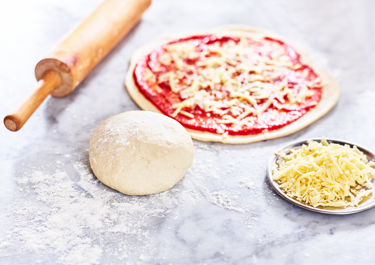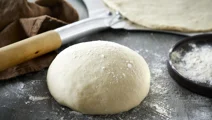No yeast pizza dough

A crisp and quick-fix pizza dough for people on the go. No yeast equals no fermentation time! Just fold together, roll out and top with any topping.
Ingredients
|
2 tsp
Baking powder
|
|
|---|---|
|
360 g
Flour
|
|
|
½ tsp
Salt
|
|
|
250 ml
Water
|
|
|
50 ml
Olive oil
|
Instructions
No yeast pizza dough
What can I use instead of yeast in pizza dough?
If you want to avoid store-bought yeast in your pizza dough, baking powder is a quick-fix alternative. Another method, far more time consuming but very rewarding, is to make sourdough pizza. A sourdough starter is made from flour and water, mixed and left at room temperature to cultivate the naturally occurring yeast in the flour. Sourdough pizza has all the chewy, crispy, fluffy characteristics of classic pizza dough, with the typical freshness of sourdough bread.
What is the secret to perfect pizza dough?
Perfect pizza dough should be crispy and chewy after baking. One secret to classic, Italian pizza is to use extra fine wheat flour, called Tipo 00. This powdery flour produces a super crispy crust in traditional Neapolitan pizzas. Try including Tipo 00 in your no yeast pizza for added texture. Another secret, applicable also to no yeast pizza, is to preheat your oven and sheet pan thoroughly before baking the pizza.
What temperature do you cook pizza dough at?
Traditional, wood-fired pizza ovens can reach temperatures around 450°C, which brings the cooking time of a pizza to under 2 minutes. This kind of temperature isn’t possible in a regular home oven. This doesn’t imply that you can’t make pizza at home. Simply set your oven at 250°C, which is often the highest temperature available. Make sure to heat the oven well before baking your pizza. By also preheating your baking sheet you get closer to a traditional pizza oven, where the hot surface helps create the perfect pizza crust.
How long should you knead pizza dough?
When making traditional pizza dough with yeast, there is a lot of kneading involved. By kneading and stretching the dough, often using a kneading machine, you develop the gluten that makes the dough fluffy and chewy. With no yeast pizza dough, there is no need to knead. Simply mix the ingredients together until the dough is smooth. Then roll your dough as thin as you want, add toppings, and bake.
How long does no yeast pizza dough last?
No yeast pizza dough is all about moving fast, getting your pizza in the oven at record speed. Once baking powder is mixed into a dough, it starts reacting with the water to create bubbles. For this reason, whenever you make a dough or batter with baking powder it’s best to start baking as soon as possible. The dough can sit for a short while in the fridge, but the baking powder’s aerating effect will decline the longer the dough sits.
Homemade pizza dough with no yeast
Craving homemade pizza with your favourite toppings – right now? This recipe is for you. By swapping yeast for baking powder, you turbocharge your dough and make it ready for baking in an instant.
Why you should make pizza dough without yeast
The classic way of making pizza dough calls for yeast and plenty of time, as the dough is left to ferment slowly in the fridge. The result is a crispy, flavourful pizza with a fluffy, chewy crust. No yeast pizza dough is not as chewy or fluffy – but it’s an alternative whenever you want to make your own pizza but can’t wait for 24 hours before digging in.
What you need for pizza crust without yeast
This no yeast alternative has most of the classic pizza dough ingredients except yeast. It’s based on wheat flour, mixed with water, extra virgin olive oil, and a good pinch of salt. Baking powder is usually a mix of sodium bicarbonate, cornstarch, and a slightly acidic component that helps kick off the aerating effect of the bicarbonate.








